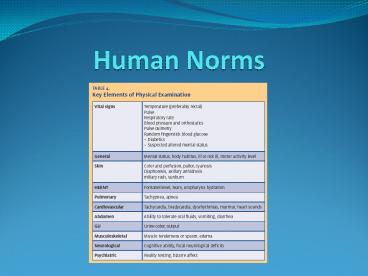Human Norms - PowerPoint PPT Presentation
1 / 18
Title: Human Norms
1
Human Norms
2
Vital Signs
- Humans have four vital signs, that if out of
their normal range, could signify a problem has
or is about to occur. - Those four vital signs are blood pressure, heart
rate, body temperature and breathing rate.
3
Feedback Loops
- Your body uses what are known as feedback loops
to check on and maintain a normal range in these
vital signs.
4
Feedback Loops
- A feedback loop consists of three parts.
- A monitor/sensor that indicates a change in a
vital sign. - A control center that recognizes the change and
issues a response. - An effector/regulator that restores the vital
sign back to its normal range.
5
Feedback Loops
- Feedback loops can be either positive or
negative. - A positive feedback loop recognizes a change and
amplifies it. - A negative feedback loop recognizes a change and
brings it back to normal.
6
Feedback Loop
7
Blood Pressure
- It is the most irregular of the vital signs.
- It falls during sleep and then rises sharply
after wake-up. - It changes quite dramatically during the day
based on the amount of activity we are undergoing.
8
Blood Pressure
- It is measured using a sphygmomanometer.
- It measures the arterial pressure in mm of Hg.
- This is an old unit of pressure, but has carried
over due its universality.
9
Blood Pressure
- Blood pressure usually averages around 115/70 mm
of Hg. - 115 is the systolic pressure, the peak pressure
of the blood in the arteries. - 70 is the diastolic pressure, the minimum
pressure of blood in the arteries.
10
Blood Pressure Feedback Loop
11
Heart Rate
- Heart Rate also changes throughout the day, but
not as much as blood pressure. - During sleep it drops, but once awake it stays
pretty consistent save for periods of high
activity. - Heart rate can also be called a pulse.
12
Heart Rate
- The pulse is commonly taken at the wrist where
the brachial artery is located. - You can feel this with your fingers or hear it
here (or in your chest) with a stethoscope.
13
Heart Rate
- As you get older your average heart rate drops.
- Newborn-Infant 130 bpm.
- Toddler 100-120 bpm.
- Child 90-110 bpm.
- Teens 80-100 bpm.
- Adults 50-80 bpm.
14
Body Temperature
- Your core body temperature various the least of
the vital signs. - It hovers around 37 degrees Celsius and only
various slightly. - This goes for every age and body type.
- Elevated body temperature usually means
infection.
15
Body Temperature Feedback Loop
16
Respiratory Rate
- The least accurate of the vital signs because it
has the most variation amongst a population. - This makes it hard to tell if a change is because
someone is sick. - The average breaths per minute can be anywhere
from 12-30 and usually decreases with age.
17
Pain
- Pain is sometimes referred to as the 5th vital
sign. - It is depends on who you ask as some perceive
pain as a subjective symptom. - There is even a pain scale which goes from 1-10.
- Pupil size has also been argued.
18
Homework Questions
- For each of the four main vital signs, indicate
your norms based on your age or your own
readings. - Which of the four vital signs are most likely
interlinked? Why do you think that is so? - What is the difference between a negative
feedback loop and a positive feedback loop? - Draw a feedback loop and indicate the monitor(s),
control center and effector(s). - What do you think happens to breathing rate when
you sleep? Why?































